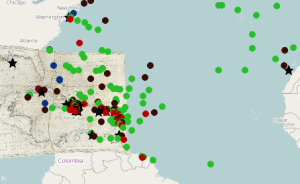Recently, I’ve been preparing a lot of new content to add to the database. The first evidence of that went into the database today. Ships mentioned in the indexes to the following resource were added to the subscription database today:
- Bennett, Jenny. Sailing Rigs: An Illustrated Guide. Annapolis, Maryland: Naval Institute Press, 2005.
- Boyer, Carl, 3rd. Ship Passenger Lists: Pennsylvania and Delaware (1641-1825). Newhall, California: Boyer, 1980.
- Bratten, John R. The Gondola Philadelphia & the Battle of Lake Champlain. College Station, Texas: Texas A&M University Press, 2002.
- Corlett, Ewan. The Iron Ship: The History and Significance of Brunel’s Great Britain. Bradford-on-Avon: Moonraker Press, 1975.
- Crisman, Kevin J., editor. Coffins of the Brave: Lake Shipwrecks of the War of 1812. College Station, Texas: Texas A&M University Press, 2014.
- Davison, Robert L. The Challenges of Command: The Royal Navy’s Executive Branch Officers, 1880-1919. Farnham, Surrey: Ashgate, 2011.
- Fowler, William M., Jr. Rebels Under Sail: The American Navy During the Revolution. New York: Scribner, 1976.
- Hampshire, Edward. From East of Suez to the Eastern Atlantic: British Naval Policy 1964-70.Farnham, Surrey: Ashgate, 2013.
- Hooper, Ralph W., Rodney P. Carlisle. Oil & Water: The Story of Interstate Oil Transport.Philadelphia, Pennsylvania: Independence Seaport Museum, 2003.
- Hunter, Louis C. Steamboats on the Western Rivers: An Economic and Technological History.Cambridge, Massachusetts: Harvard University Press, 1949.
- Lincoln, Margarette. British Pirates and Society, 1680-1730. Farnham, Surrey: Ashgate, 2014.
- Wasson, George Savary, Lincoln Colcord. Sailing Days on the Penobscot: The River and Bays as they were in the Old Days. Salem, Massachusetts: Marine Research Society, 1932.
- Woodman, Richard. Fiddler’s Green: The Great Squandering, 1921-2010 (A History of the British Merchant Navy, Vol. 5). 2010: History Press, Stroud.
- Woodman, Richard. Masters Under God: Makers of Empire, 1816-1884 (A History of the British Merchant Navy, Vol. 3). 2009: History Press, Stroud, Gloucestershire.
This is just a start; many more, including several multi-volume sets, will be added very soon.

